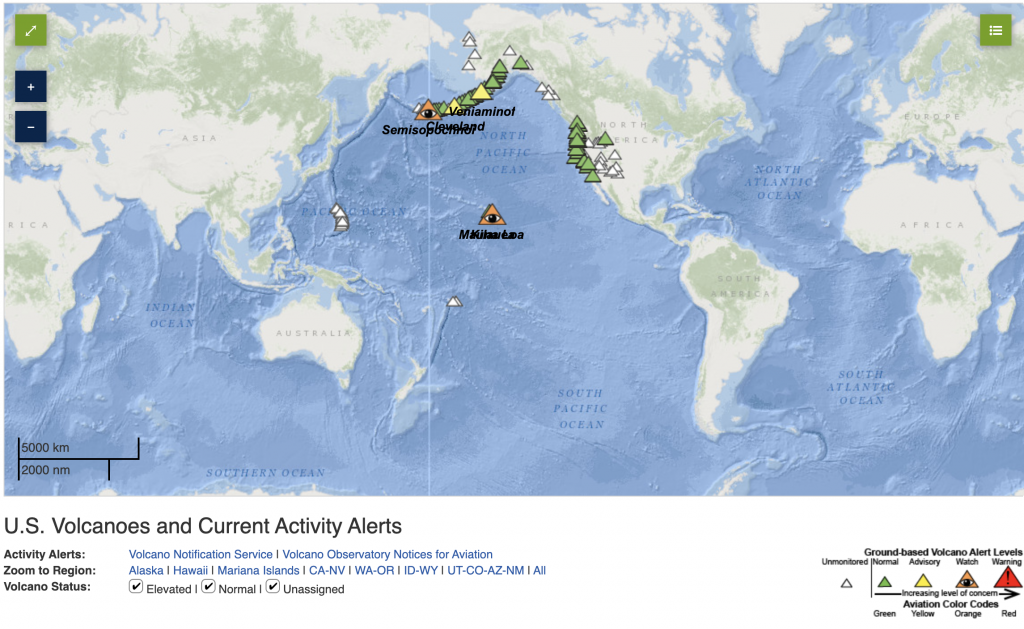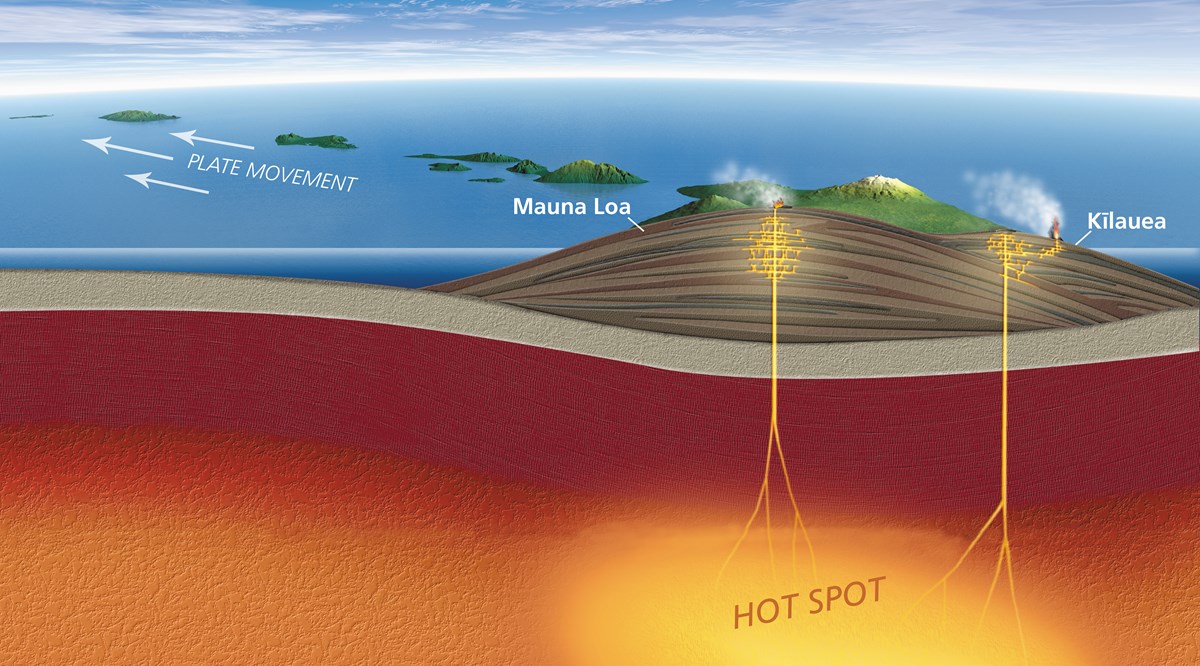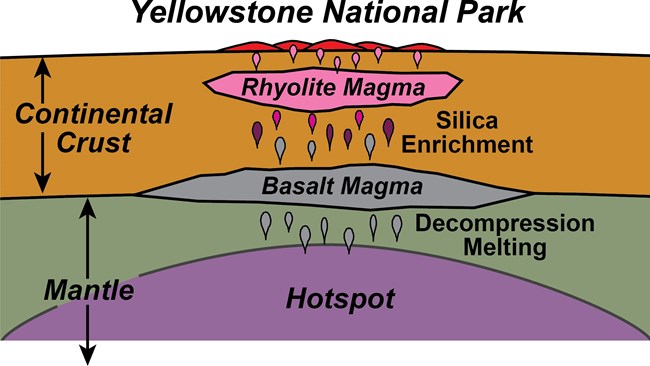4.5 Where are the Volcanoes?
Charlene Estrada
Distribution of Volcanic Activity
There are between 1400 and 1500 active volcanoes on our planet right now, but they are not evenly distributed throughout Earth’s surface. Some volcanoes cluster in specific regions. One infamous area that loosely spans the border between continents and the Pacific Ocean is known as the Ring of Fire. This region spans about 40,000 kilometers and it has significantly more volcanic and seismic activity compared with other places on the planet.

Why are so many volcanoes bunched together? Most volcanoes are formed by tectonic processes such as subduction at convergent boundaries or rifting at divergent boundaries. Therefore, the distribution of volcanoes naturally coincides with plate boundaries. This connection between volcanism and plate boundaries is called interplate volcanism. There are some volcanoes, however, that occur very far away from plate boundaries. They are typically the result of hot spot volcanism, which can occur on both continental and oceanic lithosphere.
Below we will explore some of the broad geologic environments that result in volcanism and the types of volcanoes we might expect from each.
Mid-Ocean Ridges
New lithosphere is continuously being formed at divergent boundaries. As two tectonic plates spread apart, the magma from the asthenosphere will rise to the surface and form brand new oceanic crust made of basalt and gabbro. The best example of this process at work can be found at the Mid-Atlantic Ridge, which is Earth’s longest mountain range. There are two sets of divergent boundaries at the Mid-Atlantic Ridge: the North American-Eurasian plate boundary and South American-African plate boundary. Such a long spreading center along the ocean floor is responsible for the majority of Earth’s volcanism, but because it is deep underwater, it poses little to no risk to society.

Continental Rifts
The lithosphere does not only spread apart along mid-ocean ridges! Although the continental lithosphere can be up to 100 km thick, the movement of tectonic plates can pull apart the crust. As a result, this crust will thin over time, and the lower layers of the crust and the mantle will rise. These rocks undergo decompression melting, and basaltic magma will erupt from surface volcanoes. These regions are called continental rift valleys. Most continental rift valleys form at divergent boundaries where ocean basins have not yet opened. These places are sites of continental break-up, and we can see this process occurring today at the East African Rift.
Convergent Boundaries
Convergent boundaries that form between two plates of oceanic lithosphere or at a boundary between oceanic and continental lithosphere will result in the subduction of the denser oceanic lithosphere toward the mantle. Within the subduction zone, magma will form in the overlying plate due to flux melting.
The magma that forms at the subduction zone is initially mafic; however, if it rises toward a plate composed mostly of continental crust, it will become intermediate or even felsic in composition. Stratovolcanoes typically form at convergent boundaries. The Pacific Ring of Fire is dominated by subduction zones with these explosive volcanoes.
A description of the Pacific Ring of Fire along western North America is below:
- Subduction at the Middle American Trench creates volcanoes in Central America.
- The San Andreas Fault is a transform boundary.
- Subduction of the Juan de Fuca plate beneath the North American plate creates the Cascade volcanoes like Mount St. Helens, Mount Rainer, Mount Hood, and more.
- Subduction of the Pacific plate beneath the North American plate in the north creates the long chain of the Aleutian Islands volcanoes near Alaska.
Hot Spots


Hot spots are areas of partial melting deep within the mantle that rise and erupt at the surface. They are not associated with a plate boundary, and as such, the volcanic activity that results from hot spots is called intraplate volcanism (“intra” meaning within a plate). Hot spots may form brand new islands if they erupt new material over oceanic lithosphere. These islands are usually just “the tip of the iceberg” as they are often very large shield volcanoes that have been formed by low-viscosity, mafic lava. Additionally, these islands form in chains because the lithosphere will move over millions of years due to plate motion, but the hot spot will stay in place. The most famous example of hot spot volcanism may be the Hawaiian island chain, in which the hot spot remains active over Mauna Loa and Kilauea (above).
Some hot spots form beneath continental lithosphere. Although the partially-melted mantle composition is ultramafic at depth, as it rises to the surface and mixes with the materials in within the continental crust, it becomes mafic, then intermediate. In some areas, it might even become felsic. This mixing of molten materials is a recipe for potential disaster! As the magma becomes more silica-rich, it also becomes more viscous with volatile gases, which make for a very explosive eruption. In the United States, there is one active continental hot spot volcano we are currently monitoring: the Yellowstone Caldera (above), which is likely to have a super-volcanic eruption in the next 100,000 years.
Backyard Geology: Sunset Crater National Monument Park

The Sunset Crater National Monument Park is a site of fairly recent (geologically-speaking!) volcanic activity. The park encompasses two cinder cone volcanoes; the Sunset Crater Volcano and Lenox Crater Volcano which have produced basaltic lavas and scoria from their previous eruptions. The last eruption from Sunset Crater was about 950 years ago, and it was said to result in lava fountains that were nearly 3 times higher than the Statue of Liberty. Even though Sunset Crater erupted in the past 1000 years, it is classified as extinct and it is not expected to erupt again as the hot spot has since moved eastward. We call it the “Sunset Crater” because mafic igneous rocks such as scoria have a lot of iron in them that easily rusts or oxidizes under Earth’s atmosphere from their original blackish-gray color to bright reds and purples, and pinks [10].
A volcano that has erupted at least once over the past 10,000 years and has the possibility of erupting in the future.
A region extending along the islands and coastlines bordering the Pacific ocean that is affected by convergent and transform plate boundaries. These boundaries cause a higher incidence of earthquakes and volcanoes.
Vibrations and energetic waves produced by the movement within Earth's crust and interior.
The process in which the older, denser tectonic plate at a convergent boundary will buckle and sink into the lithosphere. This plate will always be composed of oceanic lithosphere.
A region along Earth's lithosphere where at least two tectonic plates collide with one another.
an area on a continent where there is an active divergent boundary stretching and tearing the landmass apart.
A region along Earth's lithosphere where at least two tectonic plates move apart from one another.
volcanic activity that occurs between active tectonic plate boundaries.
A type of volcanic activity, that occurs independent of plate boundaries, in which a plume of molten magma from deep within the mantle upwells at the Earths surface.
The outer, relatively rigid layer of the Earth that is composed of crust and upper mantle.
molten rock that can be found beneath the Earth's surface.
A ductile but solid, hot layer in the Earth composed of the lower crust and upper mantle that flows like putty over long periods of time. It drives the movement of the rigid tectonic plates riding above.
A type of rigid, thin crust made of iron and magnesium rich minerals that is found beneath the planet's oceans.
an igneous rock that is mafic and fine-grained. Basalt is dark and makes up the majority of the oceanic crust.
A mafic, coarse-grained igneous rock that is often dark-colored. Gabbro makes the majority of the Earth's oceanic crust beneath the surface.
The world's longest mountain chain found beneath the Atlantic ocean between North America, South America and Europe and Africa. The Mid-Atlantic Ridge is an example of a mid-ocean ridge, or MOR.
A region on the ocean floor where magma from an active divergent boundary is creating new oceanic lithosphere, thus pushing or spreading the older lithosphere outwards.
(sometimes abbreviated as "MORs" by scientists) an underwater mountain ridge in the middle of the ocean that is formed by seafloor spreading centers at divergent boundaries.
The thin, outermost layer of Earth composed of rigid rock, which is home to all known life on the planet.
A hot interior layer of solid rock between the crust and core that is capable of plastic flow. The mantle is the largest layer of Earth.
The process in which solid rock melts upon experiencing a sudden decrease in pressure, but not temperature.
a process in which solid rock melts because volatiles such as water vapor have caused its melting point to decrease.
Originating from an iron and magnesium-rich magma/lava composition.
Thick crustal material mostly made of feldspar and silica rich minerals which forms the world's large landmasses.
A composition of igneous rocks, magma, and lava that is between felsic and mafic.
originating from a feldspar and silica-rich magma/lava composition.
A tall and steep conically-shaped volcano built upon past layers of hardened ash and lava flows. Also known as a composite volcano.
A region along Earth's lithosphere where at least two tectonic plates slide past one another.
Volcanic activity that occurs away from a tectonic plate boundary and is not the result of plate interactions.
A large type of volcano characterized by broad, shallow slopes formed by low-viscosity mafic lava flows.
a liquid's resistance to flow or movement
A magnesium and iron rich rock that contains very little silica.
a compound composed of silicon and oxygen in the formula SiO2.
Gases dissolved within magma or lava.
A small type of volcano that is cone-shaped, steep, and built from mafic ash cinders and large volcanic rocks.
A mafic, vesicular igneous rock. Scoria is dark-colored, extrusive, and contains many cavities. However, it cannot float on water.
A volcano that is not currently erupting and is not expected to erupt in the future.

